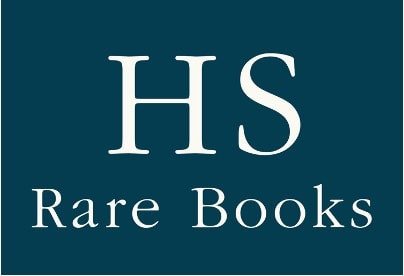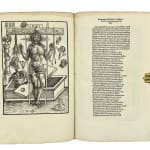![Ulrich Pinder and Geiler von Kaysersberg, Exceptional sammelband of first editions by Ulrich Pinder and Geiler von Kaysersberg, most important illustrated works in the contemporary binding., I. Pinder, Ulrich. Speculum passionis domini nostri Ihesu Christi. 30 August 1507. Nuremberg. [Friedrich Peypus at the author’s press]; II. Geiler von Kaysersberg, Johannes. Passionis Christi unum ex quattuor evangelistis textum (edited by Philesius Ringm](https://artlogic-res.cloudinary.com/w_1600,h_1600,c_limit,f_auto,fl_lossy,q_auto/artlogicstorage/hsrarebooks/images/view/66a25c2dc33e22adf9cb18ba741978edj/hsrarebooks-ulrich-pinder-and-geiler-von-kaysersberg-exceptional-sammelband-of-first-editions-by-ulrich-pinder-and-geiler-von-kaysersberg-most-important-illustrated-works-in-the-co.jpg)
![Ulrich Pinder and Geiler von Kaysersberg, Exceptional sammelband of first editions by Ulrich Pinder and Geiler von Kaysersberg, most important illustrated works in the contemporary binding., I. Pinder, Ulrich. Speculum passionis domini nostri Ihesu Christi. 30 August 1507. Nuremberg. [Friedrich Peypus at the author’s press]; II. Geiler von Kaysersberg, Johannes. Passionis Christi unum ex quattuor evangelistis textum (edited by Philesius Ringm](https://artlogic-res.cloudinary.com/w_1600,h_1600,c_limit,f_auto,fl_lossy,q_auto/artlogicstorage/hsrarebooks/images/view/4895920445f9858bfa7b28dfbd6bb028j/hsrarebooks-ulrich-pinder-and-geiler-von-kaysersberg-exceptional-sammelband-of-first-editions-by-ulrich-pinder-and-geiler-von-kaysersberg-most-important-illustrated-works-in-the-co.jpg)
![Ulrich Pinder and Geiler von Kaysersberg, Exceptional sammelband of first editions by Ulrich Pinder and Geiler von Kaysersberg, most important illustrated works in the contemporary binding., I. Pinder, Ulrich. Speculum passionis domini nostri Ihesu Christi. 30 August 1507. Nuremberg. [Friedrich Peypus at the author’s press]; II. Geiler von Kaysersberg, Johannes. Passionis Christi unum ex quattuor evangelistis textum (edited by Philesius Ringm](https://artlogic-res.cloudinary.com/w_1600,h_1600,c_limit,f_auto,fl_lossy,q_auto/artlogicstorage/hsrarebooks/images/view/879c38de76d47d6ab927012785b1850bj/hsrarebooks-ulrich-pinder-and-geiler-von-kaysersberg-exceptional-sammelband-of-first-editions-by-ulrich-pinder-and-geiler-von-kaysersberg-most-important-illustrated-works-in-the-co.jpg)
![Ulrich Pinder and Geiler von Kaysersberg, Exceptional sammelband of first editions by Ulrich Pinder and Geiler von Kaysersberg, most important illustrated works in the contemporary binding., I. Pinder, Ulrich. Speculum passionis domini nostri Ihesu Christi. 30 August 1507. Nuremberg. [Friedrich Peypus at the author’s press]; II. Geiler von Kaysersberg, Johannes. Passionis Christi unum ex quattuor evangelistis textum (edited by Philesius Ringm](https://artlogic-res.cloudinary.com/w_1600,h_1600,c_limit,f_auto,fl_lossy,q_auto/artlogicstorage/hsrarebooks/images/view/c4c3233b8bc4920ab55569b93fe59027j/hsrarebooks-ulrich-pinder-and-geiler-von-kaysersberg-exceptional-sammelband-of-first-editions-by-ulrich-pinder-and-geiler-von-kaysersberg-most-important-illustrated-works-in-the-co.jpg)
![Ulrich Pinder and Geiler von Kaysersberg, Exceptional sammelband of first editions by Ulrich Pinder and Geiler von Kaysersberg, most important illustrated works in the contemporary binding., I. Pinder, Ulrich. Speculum passionis domini nostri Ihesu Christi. 30 August 1507. Nuremberg. [Friedrich Peypus at the author’s press]; II. Geiler von Kaysersberg, Johannes. Passionis Christi unum ex quattuor evangelistis textum (edited by Philesius Ringm](https://artlogic-res.cloudinary.com/w_1600,h_1600,c_limit,f_auto,fl_lossy,q_auto/artlogicstorage/hsrarebooks/images/view/5c410e44aeedac2d33632320bef82d88j/hsrarebooks-ulrich-pinder-and-geiler-von-kaysersberg-exceptional-sammelband-of-first-editions-by-ulrich-pinder-and-geiler-von-kaysersberg-most-important-illustrated-works-in-the-co.jpg)
Ulrich Pinder and Geiler von Kaysersberg
Rare first editions of Pinder and von Kaysersberg’s remarkable illustrated works, along with Coccius Sabellicus’ Hebrew history, all housed in the contemporary binding, and in exceptional condition.
Further images
Folio, (310 x 210 mm). Blind-stamped contemporary quarter pigskin over wooden boards, remains of two clasps. Some rubbing and staining, lower joint restored, a few wormholes. In a modern cloth slipcase .Light damp-staining to upper margins, a very few leaves slightly browned, minor worming. I: Negligible traces of an erasure on title, two leaves misbound (XIX and XXI). A well- preserved copy with fine and dark impressions of the woodcuts.
Contents:
I. Ulrich Pinder, Speculum passionis domini nostri Ihesu Christi.
92 leaves, complete including the final blank, ff. [1], XC, [1]. – With 77 (39 full-page, 5 repeats) woodcuts by Hans Schäufelein, Hans Baldung Grien, and Hans Süß von Kulmbach.
First edition of the Mirror of the Passion “Speculum passionis”, created by the employees of Durer, compiled from the New Testament and the Early Fathers, the work is in the tradition of the passion tracts of the late Middle Ages and follows Bonaventura’s order of contemplatio, imitatio, admiratio, exultatio, resolutio, quies.
Pinder had many of his books illustrated by the workshop of Albrecht Dürer. He had most probably ordered the woodcuts for the Speculum by the end of 1505. As the Master, from the summer of 1505 until the spring of 1507, was on his second visit to Italy, the cuts for the Speculum Passionis were created by three of Dürer’s employees. The result was one of the finest illustrated books of the 16th century.
With the seventy-seven woodcuts (thirty-nine of which are full-page) Pinder and the artists created a new type of devotional book in which the illustration is of equal status with the text. This monumental series can only be compared to Dürer’s Apocalypse of 1498, and the success of Pinder’s ‘picture book’ probably prompted Dürer to publish his three large woodcut series (The Large Passion, The Life of the Virgin, and The Apocalypse) in book form in 1511.
Thirty of the large cuts are by Hans Schäufelein (c. 1480/85-c. 1539) and form the artist’s first large series. The final cuts, The Pentecost and The Last Judgement, demonstrate a shift towards a clear disposition of space and figures –a reflection of Dürer’s ideas– and later furnished the inspiration for some of the scenes in Dürer’s Small Passion of 1509-11. Two of the large cuts (leaves 51v and 54r) are by Hans Baldung Grien (c. 1484/85-1545); and the one on leaf 21v is by Hans Süß von Kulmbach (c. 1480-1522). The majority of the smaller cuts, and a very few of the larger ones, had been used before in Pinder’s Beschlossen Gart des Rosenkrantz Mariae (1505).
Pinder set up his private press in 1505, and produced eleven books, in large part of devotional character, written or compiled by Pinder himself. The press was run by Friedrich Peypus (1485-1534), and when Peypus in 1512 married Pinder’s daughter Martha, Pinder gave the shop to his son-in-law. He was town physician of Nördlingen from 1484 until 1489, subsequently personal physician to the Elector Frederick of Saxony (1489-1493) and Nuremberg’s town physician until his death (1519).
Panzer VII, p. 446, 48; Proctor no. 11031; Adams P-1243; Davies, Fairfax Murray (German), no. 333; Dodgson I, 505, 5 (‘Traut’); II, 5, 1; Hollstein II, 84, 15-49; 128, 212-214; Oldenbourg, Schäufelein, L-4 (woodcuts 153 and 167-195 with 15 figs.).
II. von Kaysersberg, Johannes Geiler. Passionis Christi unum ex quattuor evangelistis textum (edited by Philesius Ringmann). 1506. 26 ff., complete, collation A-C6, D8, contemporary manuscript foliation in ink. With 26 full-page woodcuts by Urs Graf (1 repeat).
First edition, published shortly before the first German edition (1506). Johann Geiler (1445-1510) was a native of Schaffhausen, brought up in Kaysersberg (Alsace), and educated at the newly founded universities of Freiburg and Basel. He became a doctor of theology in 1475 and from 1478 lived in Strasburg as a preacher at the Cathedral. Later called the ‘German Savonarola,’ he was one of the most effective and forceful advocates of Church reform at the end of the 15th century.
Geiler himself published only a few texts, while most of his sermons were written down by his audience or were transcribed posthumously from his notes. The Latin text on the Passion is one of the rare examples of his own writings published during his lifetime. It is a response to the French theologian Jean Gerson, compiled from the four Gospels and Gerson’s Gospel harmony Monotessaron.
On the title we find a dedicatory poem, Ringmannus Philesius ad lec. The humanist Matthias Ringmann, named Philesius (1482-1511), who worked as a corrector with, amongst others, Grüninger and Knobloch, edited the Latin text and also translated it into German; the work is thus frequently called the ‘Ringmann-passion.’ Both the Latin and the German editions were a great success. The first editions were followed by at least four more in each language until 1513, all of which were printed in Knobloch’s press.
This is the first major work of book illustration in large format by Urs Graf (1485-1527/28), containing a cycle of unconventional, highly vigorous illustrations of the Passion of Christ. The son of a goldsmith in Solothurn, Urs Graf received his initial training in his father’s workshop, but also practiced the arts of drawing, painting and cutting medals. Besides his artistic activity he repeatedly enrolled as a mercenary soldier. After a rather itinerant life with stays in Strasbourg, Basel and Zurich, he eventually settled in Basel in 1509.
His first commission for the printing business was a world map for Gregor Reich’s Margarita Philosophica of 1503. The present woodcuts of the Passion of Christ are his first major contribution to book illustration. Work on this cycle seems to have extended over a long period. The scene of Jude returning the money after the betrayal bears the date 1503 inscribed upside down on a scroll. All the woodcuts, with the exception of ‘Christ at the house of Martha and Maria’ and ‘The Last Supper’, are signed VG (V=U), while the ‘Raising of Lazarus’ is signed V only. In this woodcut Graf used a composition which an anonymous master had created for Grüninger’s Heiligenleben of 1502.
The woodcuts fill the entire page, with the text usually juxtaposed on the opposite page, although there are some exceptions. The woodcut depicting ‘The Penitent Jude’ with the date 1503 (fol. C3v) is the only one with a frame, consisting of columns and an arch composed of branchwork, which is set in front of the scene itself The leaf of ‘Jude receiving the money’ (fol. B3v) in part recalls the layout typical of miniatures, with an arch forming an inner frame. The most unusual scenes are those set in interiors, in which Urs Graf completely renounces all accessory elements that might come between the subjects and? (or that might distract?), the eye of the beholder e.g. in ‘Christ Before Hannas’ (fol. C1v) or, even more radically, ‘The Last Supper’ (fol. B4v). In these examples Graf reveals his experimentalist inclinations. Yet he was also ready to fall back on the ideas of a mentor (perhaps Matthias Ringmann?), as is shown by the inclusion of Hebrew and Greek quotations in the woodcuts.
Initially the cycle seems to have been planned with the twenty-five woodcuts by Graf only. The text, however, required twenty-six illustrations, which resulted in the double use of the pre-penultimate woodcut depicting ‘The three Marys at the sepulchre’ (fol. D7) in the present first edition. As this was regarded as awkward in such an extremely lavishly illustrated book, a woodcut of the ‘Resurrection’ from Johannes Wechtlin was added in subsequent editions.
The arms of the printer Schott next to the arms of Strasburg on the leaf of ‘Christ before Pilate’ have led to the supposition that it was Schott who had originally commissioned the woodcuts, and that he had then handed them over to Knobloch, possibly forced by a rather tight financial situation (Hieronymus no. 29).
Johann Knobloch the Elder (d. 1528) became a citizen of Strasbourg in 1501. A prolific printer, he worked in his own press, Zur Turteltaube, in the Halbmondgasse, as well as in those of his colleagues Johann Prüss, Johann Schott, his stepson Martin Flach the Younger, Konrad Kerner and Heinrich Gran (Hagenau). In addition to Urs Graf he also employed Wechtlin and Baldung Grien as illustrators.
VD16 B 4690; Rowlands, Hollstein’s German Engravings, Etchings and Woodcuts, vol. XI: Urs Graf, Amsterdam 1977, no. 4-28; Compare Adams J- 171 (German edition 1506) and Kostbare illustrierte Bücher des sechzehnten Jahrhunderts in der Stadtbibliothek Trier, exh. cat. 1995, no. 12 (German edition).
III. Marcus Antonius Coccius Sabellicus, Historia Hebreorum ex Enneadibus excerpta. (Edited by Johannes Kusswerth). 114 ff., collation A-R6, S8, numbered [4], CIX, [1]. – Title printed in red and black, with full woodcut border by Urs Graf and woodcut publisher’s device.
Only edition. Marco Antonio Sabellico (1436-1506), an Italian humanist and historian from Venice, was a member of the circle of Aldus Manutius, and became the librarian of San Marco with responsibility for the library of Cardinal Bessarion (now Biblioteca Marciana). His comprehensive history of the world in ninety-two books, Enneades sive rapsodiae historiarum (1504), is considered the first humanistic work of its kind.
The present history of the Jews is an excerpt of that world chronicle, edited by Johannes Kusswerth (or Kusthuert) from Weißenstadt in Franconia, who dedicated the work to the duke of Saxony, Frederick the Wise.
The publisher and bookseller Ludwig Hornken (d. 1521) is recorded in Leipzig, Paris and Cologne, where he had shops, at times in partnership with the better-known Cologne publisher Goddert Hittorp. Hornken also had business connections with Basel and had some of his books printed there by Adam Petri and others.
VD16 S 8; Adams S-13; Hieronymus II, 131 note.
Join our mailing list
* denotes required fields
We will process the personal data you have supplied in accordance with our privacy policy (available on request). You can unsubscribe or change your preferences at any time by clicking the link in our emails.





